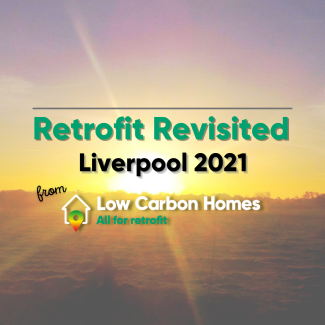Liverpool retrofit revisited

We examine Liverpool's focus on retrofit's role in supporting local economic recovery

Focus for our Liverpool domestic retrofit conference was on best practice and retrofit’s role in supporting local economic recovery. This Low Carbon Homes conference for Liverpool also saw panellists debate delegates’ questions on some of the knottier issues surrounding financing and training, adding real engagement and interactivity to our forum.
Panellists agreed this was a brilliant opportunity for contractors to enter the retrofit space.
Liverpool’s political leaders opened our conference by underlining the city’s huge potential for being a retrofit agenda leader.
Councillor Barry Kushner, Liverpool Council Cabinet Member for Housing and Regeneration, looked back to history to highlight the prime opportunity the pandemic presented to the city region. “I wanted to start by talking about the cholera epidemic,” Cllr Kushner announced, “which ravaged the country throughout the nineteenth century in a similar way we’re experiencing with COVID-19 now. “Cholera affected all of the major cities, particularly Liverpool. Dr William Henry Duncan was the Chief Medical Officer for Liverpool at the time, and Britain’s first medical officer for health. He observed cholera was spreading among people living in overcrowded basements without access to natural light or toilets, and a lack of sewage systems. “Dr Duncan made it his life’s work that the lessons of the epidemic were translated into changes in people’s lives,” Cllr Kushner said. He cited the pandemic as an opportunity for Liverpool to create “transformational change” through retrofit, just like Dr Duncan aspired to do in the nineteenth century.

The Liverpool councillor pointed towards the city’s commitment to be carbon neutral by 2030, which means getting all properties to at least EPC Band C by that year. He also highlighted that 17% of Liverpool households currently live in fuel poverty to illustrate the pressing socio-economic need to refurbish homes. Opportunities clearly abound for industry stakeholders to land domestic retrofit projects.
A breadth and depth of solutions
Cllr Kushner then move on to the retrofit challenges facing Liverpool, the main one being the age of the city’s housing stock.
“There’s about 230,000 homes here in the city of Liverpool. Of those, 60% were built before 1944, compared to the national average of 35% - 35% of that stock was built pre-1919.” This means Liverpool has lots of houses without insulation and which are difficult to insulate, he explained.
Professor Mike Riley, Pro-Vice Chancellor at Liverpool John Moores University (JMU) for Engineering and Technology, identified many barriers to retrofit such as a lack of user demand, a lack of clear and consistent government policy, and a lack of finance. However, like Cllr Kushner, Professor Riley focused on housing stock age as a potential barrier.

“Much of the city’s housing stock predates the middle of the twentieth century. The structure, the fabric, the ventilation and the heating conditions in those properties are still sub-optimal in terms of dealing with the zero carbon agenda,” Professor Riley highlighted.
For this reason, JMU had embarked on a cutting-edge project to identify the best ways to reduce emissions in Liverpool’s existing homes.
“In partnership with the Building Research Establishment we created an Innovation Park, on which we have built a series of exemplar housing which mimic the typologies of the houses in the existing building stock,” Professor Riley pronounced.
“We currently have four houses on site each built using structural and technological typologies from the 1920s, 1970s or the 2000s.” Professor Riley then explained how “systematic modelling” on the homes meant the university could “trial interventions virtually”, allowing for “a breadth and depth of refurbishment solutions” depending on the house’s typology.
“This represents our main departure from current approaches to retrofit,” he continued. “Instead of using an approach built on grants and the provision of certain equipment and technologies such as boilers or heat pumps, our approach is to go back to basics, and look at the science and performance of each house, by conducting air permeability tests, thermal imaging, and health loss tests.
“We can see what the best sequence of measures is, rather than simply applying individual interventions on the basis that they might be presented as a national policy based on grants.”
Beyond bricks and mortar
Louise Davies, Development Director for Liverpool City Council, explored the shortcomings of national policy-based refurbishment grants, and outlined what a good approach would be going forward.

“Those of us who have been around long enough will remember the famous Housing Market Renewal Initiative (HMRI). It was littered with controversy. There were some successes. In the Liverpool city region, it generated £5.8bn in local economic activity, created 19,000 jobs in construction and related industries, and sustained more than 2,600 jobs each year.
“But it only went part of the way. There was a lot of focus on demolition, and I think there were many years spent on acquiring stock, and councils being able to take control of obsolete properties, and plan regeneration programmes accordingly.” But private rented sector investment was gathering pace.
This led Louise to outline the ‘Liverpool conundrum’ to attendees. “It’s important to stress that this goes beyond bricks and mortar. We’ve still got to do a whole refurbishment on some of these homes. But a lot of these areas need overall environmental improvements.”
Some of the city’s wards “need more than a fabric first approach,” Louise argued. “We’re talking about wholesale environmental neighbourhood improvements – neighbourhood approaches – and making sure it’s more than just about the properties.”
An investment, not a cost
Other panellists also emphasised taking the right approaches to retrofit would unlock real value.
The interactive Q&A at the end of our conference saw panellists debate delegates’ questions on some of the thorniest issues surrounding retrofit in the Liverpool city region. One attendee asked the panellists what the viability of retrofit in Liverpool was, given property prices were so low.
Charlie Baker, Founder & Director of Red Cooperative, highlighted some alternative financing models which could make it more affordable, advising us that “A report we wrote for the West Yorkshire Combined Authority says you need to create your own lender, or a revolving loan fund, which can take policy-led decisions on where the money goes, rather than just chasing profit.”
Charlie estimated the capital cost to retrofit a typical terrace house as being £50,000. “Bear in mind there’s no retrofit industry to speak of at the moment and no economies of scale,” he pointed out, indicating it could be lower if scaled up across the city region. “It could also have been if we’d taken all of the refurbishment costs out and paid for the renewables with that.”

Marianne Heaslip, Associate Principal at URBED, agreed with Charlie that it was possible to get costs per home under £50,000 if money was spent “cannily”, and argued that we needed to rethink how we thought about financing retrofit.
“It’s crucial we see this as an investment, rather than a cost. It’s not the case that you pay that money and it’s gone. It’s created some kind of value, as long as you do it well. I think the problem we’ve had with previous retrofit schemes is that they’ve destroyed value because they’ve been done badly, like at Fishwick Road in Preston.”
Hard labour
Other panellists agreed that retrofit could create huge economic value for the Liverpool city region if done correctly.
Wendy Osborn, Partnerships Manager at the CITB: Construction Industry Training Board predicted that “retrofit work will account for a significant amount of green jobs created in construction”. Moving into the retrofit space was a huge opportunity, with domestic retrofit potentially able to create 330,000 construction jobs nationwide. Wendy informed attendees that CITB had forecast a fall in construction employment of between 10-14% of the workforce between 2020 and 2025. “So there will be a great opportunity to reskill the existing construction workforce as part of the green recovery,” she said.

However, Wendy pointed out there were several key barriers to accessing these jobs. “Demand for skills and training linked to net zero is currently low,” Wendy underlined. “This problem is likely to persist, unless demand is stimulated.”
“Training supply is also not NetZero-ready. Typically, the focus of existing training is skewed towards new build and on-site construction.” Wendy also highlighted that the “reputation of the construction sector limits the pipeline of the talent needed.” Training providers also struggle to recruit qualified teaching staff, Wendy said.
Cllr Kushner highlighted some of the administrative hurdles regional contractors faced. “I think there’s obviously loads of companies in the city region who can register and implement a lot of this work, but they’ve got to get a PAS2030 registration and then a Trustmark registration.
“This isn’t the kind of thing small contractors are used to doing. I think the process needs simplifying.
Panellists offered examples of the resources available to local businesses looking to enter the retrofit space during the Q&A session.
“For heat pump installers, if you’re a qualified plumber there are three- to five-day courses available for you to use your knowledge of heating systems and top it off with lessons on installing a heat pump,” Ian Rippin, CEO of MCS Certified.

Ian also highlighted a skills training competition under the government’s Green Homes Grant which can fund up to 70% of an installer’s training.
Ian also informed attendees that MCS Certified had relocated to Liverpool which will provide a real boost to the region’s small-scale renewables sector. “There’s lots of things coming which will help the city region and its supply chain, particularly in skills,” Ian announced.
Pushing towards net zero
Our panel also highlighted knowledge transfer partnerships (KTPs) as a way of capitalising on retrofit business opportunities. KTPs are funded partnerships with academics and researchers with the aim of improving businesses’ competitiveness and productivity, and are a good way for businesses to collaborate with universities on work that will have real impact.

Dr Lisa Newson, Reader in Applied Health Psychology at JMU, was a Principal Investigator on the KTP looking at the question of how the university could help with retrofit decisions. She recommended that businesses form KTPs. “One of the best things about KTPs is the structured project management which will lead to the delivery of the project.”
Professor Riley emphasised the university’s commitment to facilitate retrofit. The university was “heavily invested as a stakeholder in the city region to support the push towards net zero,” he said. “We’re keen to move forward on establishing a housing research group, build on knowledge from housing associations, and focus on sharing the benefits and outcomes to everyone.”
The Liverpool's event chair, Prof. Andy "We've learnt a great deal about the macro issues - it's a region with unique challenges and we can see more on where we sit compared to other regions around the country. We looked at the technical solutions...and what keeps coming across is the issue of scale and the supply chain and the demand and geographical issues in the region - and the successes such as Granby Street which had kept the heritage and the local flavour of the city. It shows we have to be sensitive to how we make these interventions."

(since retired)
Prof. Andy Ross, who chaired the entire event, summarised the key learnings from the Liverpool sessions: "Getting young people into this industry and addressing their fears that there is a long-term future in this industry...raising awareness with school leavers about the opportunities, and the issue about diversity in this area...curriculum development and the use of the apprenticeship levy - [these] all reducing barriers to the human [retrofit] supply chain entry." The future in this area is multi-disciplinary. Prof. Ross went on to conclude "It's been a great opportunity to bring in all these different stakeholders [who will] look to develop a retrofit research group to address some of these issues locally and give us a real opportunity as a city to raise our profile nationally on what we're doing and how we can achieve the challenging targets for 2030."
Retrofit Glossary of Terms
| Term | Definition | Source |
|---|---|---|
| Deep /whole house retrofit | A complete retrofit approach where a house is treated as a joined-up system focusing on building fabric first, to strategies for heating, ventilation and cooling. This ensures that measures work together effectively and efficiently in the long-term. | TrustMark. 2020. Whole House Retrofit - A Consumer Guide. London: BEIS. |
| Fabric first | A retrofit strategy advocating for the building fabric improvements such as insulation as the priority measure. | Institute for Sustainability. 2012. Retrofit insights: perspectives for an emerging industry. London: UCL Energy Institute and Technology Strategy Board. |
| Fuel poverty | Fuel poverty is defined as households who spend 10% or more of their income on domestic energy use, meaning that they cannot maintain an adequately warm home. | Rosenow, J. 2012. Energy savings obligations in the UK – a history of change. Energy Policy. 49, pp. 373-382. |
| PAS 2030:2019 | PAS 2030:2019 is the industry specification (previously PAS 2030:2017) to which all energy efficiency installers must be certified and compliant with when carrying out energy efficiency measures under government initiatives. | TrustMark. 2020. Support for gaining Publicly Available Specifications (PAS) and Microgeneration Certification Scheme (MCS) Certification. [Online]. Available from: https://www.trustmark.org.uk/tradespeople/how-to-become-pas-mcs-certified#questions |
| PAS 2035:2019 | PAS 2035:2019 is the overarching specification for a framework of new and existing standards, promoting a whole house retrofit approach. Once an installer updates their certification to PAS 2030:2019, the PAS 2035:2019 requirements commence. | Elmhurst Energy. 2020. PAS 2035 for Installers. [Online]. Available from: https://www.elmhurstenergy.co.uk/pas-2035-installers |
| Retrofit | The retrospective fitting of building fabric improvements like insulation, low carbon HVAC, such as heat pumps and integrated renewables like PV panels, to improve the energy efficiency, health and comfort of a house and reduce its CO2 emissions. | Putnam, T. 2020. Grassroots retrofit: The role of community-led approaches in the UK's residential retrofit challenge. Master's thesis, University of Leeds. |
| Thermal comfort | Thermal comfort is defined as the condition of mind that expresses satisfaction with the thermal environment, and refers to a number of conditions in which most people feel comfortable. |
Camuffo, D. 2019. Temperature: A Key Variable in Conservation and Thermal Comfort. In: Camuffo, D. ed. Microclimate for Cultural Heritage. [Online]. 3rd edition. Amsterdam: Elsevier, pp. 15-42. |
Author

Article written by: Alex King | LinkedIn | Twitter @alexdpking